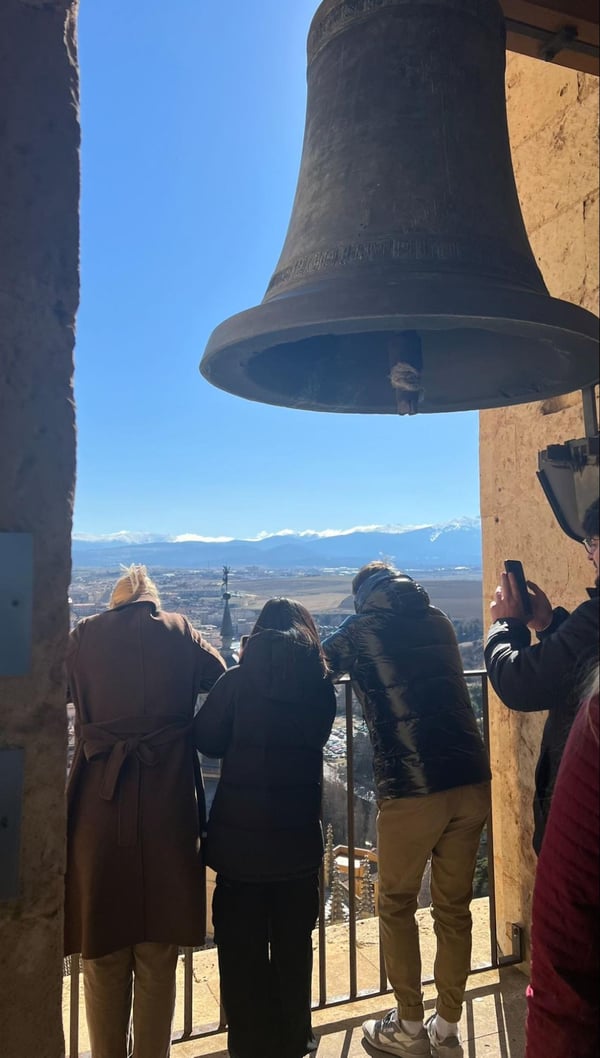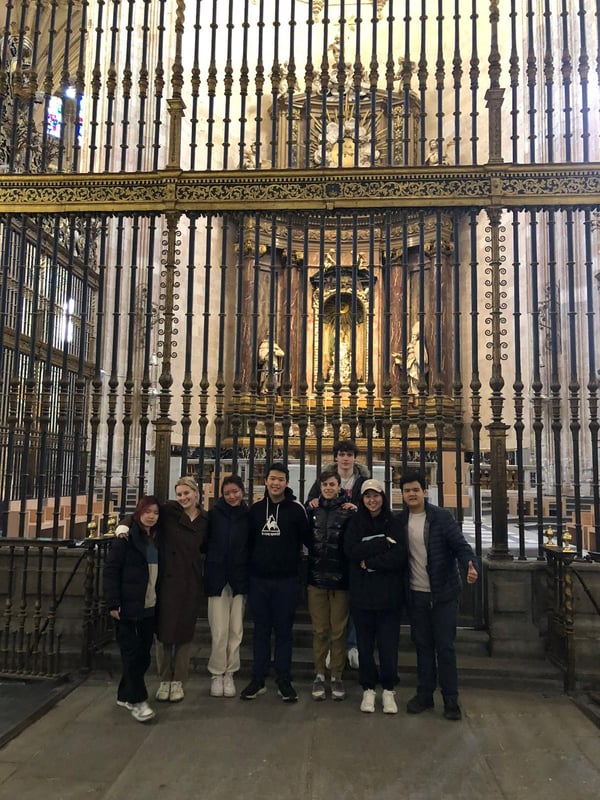Each term Proctor en Segovia students live in Spain for more than two months, immersed in Spanish culture, language, and the rhythms of their host families. They exist in an in-between space; they are not quite local residents but are much more than tourists visiting for a day or two. By engaging with locals -- program directors, Spanish faculty, afternoon activity instructors, host families, teammates, and new friends --, they open themselves up to new perspectives and powerful learning experiences.

Yiling '23 - Catedral de Segovia
The Segovia Cathedral has been on the Plaza Mayor of Segovia for a long time, not only since 1525 but also since the day we arrived in Spain. It is the landmark of Segovia, the place where almost all the tourists go. However, for us, the group of tourists who have stayed here for two months, last Friday was the first time we visited the cathedral.

Thanks to the Spanish presentation on Segovia's cathedral that Ingrid P. '23 and I were in charge of, we, people who always passed by the cathedral, had the opportunity to go inside the cathedral and visit it.
Segovia Cathedral was the last Gothic-style Roman Catholic cathedral in Europe, and there are 21 chapels there. Even though I had researched tons of information and photos of the cathedral before visiting there — for the presentation — the sense of astonishment when I first saw the decorations and vidrieras (stained glass windows) was hard to describe with words. The only thing left for all of us was "WOW" at that special moment.

After touring the cathedral for about 1 and a half hours, we finally arrived at our main destination of the cathedral — the tower. In the past, there was a campanero (bell ringer) who lived all the way up in the tower with his family and even cattle. It was difficult for the bell ringer to get daily supplies, so what people did was contact the bell ringer with a big stone, which was (and is) at the outside of the tower so that they could hit it from below to notify the bell ringer. After that, the bell ringer would drop a bucket with a string to get the supplies from the ground.
 Check out Segovia's Roman aqueduct in the distance!
Check out Segovia's Roman aqueduct in the distance!
The only way to go up the tower is to climb the 152 stairs. It doesn't sound like a lot, but it was harder than I expected. Basically, it is a spiral staircase without banisters that goes to the top. Before going to the top, we got the English / Chinese version interpretation in the headphones that the cathedral offered, which helped me a lot because I didn't need to stare at the Spanish interpreter and pretend that I understood what he said. There were three places where we could take a rest from the dizzy staircases: the historical screening room, the campanero's house, and the bells. However, just like Rosa (our Spanish teacher) said, after seeing the view from the top of the tower, it was all worth climbing the 152 emetic stairs. Segovia was in full view. I won't spoil it with more information on the cathedral because it is and it will be here waiting for you to explore. But I have one more friendly reminder: If climbing up the cathedral was as hard as having a no-carb diet in Spain for me, going down the spiral staircase was like being a vegetarian at the North Pole — nearly impossible. I didn't know that I had vertigo until I went down the tower without taking a rest.
Eric '23 - Soccer Practice
Every Monday and Thursday Tony Hu '23 and I get the opportunity to train with one of the best clubs in Segovia, Gimnastica Segoviana. The experience has been, without a doubt, a highlight of the program for me. All of my teammates were super welcoming from day one, and I have made some new great friends. They are laughing and joking before practice but get to business when practice starts, a sign of a great team!

Practices in Spain aren't too different from soccer practices in America. However, there have been some drills I have never performed in my lifelong soccer career. The most notable difference I learned during my first practice is that water breaks are not a thing for these players. I found this out the hard way. Training with this team has been an immersive experience I will never forget. I am not confident in my Spanish skills, but working together with my teammates and combining the small amount of English they know, and the small amount of Spanish I know to make out what is being said by the coach has been such a fun time. I did run into a bit of a roadblock while waiting for the bus this past Thursday. It turns out that public transportation workers are protesting at the moment, and on Tuesdays and Thursdays, the bus schedules are messed up. I was stressed out at first because I thought I was going to be late for a practice which would definitely not be tolerated. However, when a teammate showed up and told me about the situation and read a text from the coach that assured me he understood, I was relieved. It reminded me of how stress-free life here in Segovia is.
Eric '23 reflects on soccer practice in Segovia

Eric '23 - San Antonio de la Florida
This past Saturday, our group made our third visit to Madrid to see San Antonio de la Florida. In Luis' Spanish art history class, we typically learn about a new artist/art technique every week. This leads us up to museums or art galleries we go to see in Madrid on weekends, or during our excursions. This week we learned about an artist named Francisco Goya and how he impacted Spanish art history. Goya specialized in romanticism, which is a technique more geared towards one's imagination rather than reality. Goya was considered the last of the original masters of art, and the first of the modern art era. Goya painted a historic, beautiful mural on the ceiling of the Royal Chapel of San Antonio. Another notable fact about San Antonio is this is where Francisco Goya was buried. A fun fact Luis mentioned in class was Goya was actually buried without his head! It is not known where the head is, whether it was stolen or lost.

Cooking class at the Proctor en Segovia Center on the Plaza Mayor
This location stood out to me like none of the others did. It was not a museum or an art gallery, but it was a royal chapel. One open room with the beautiful mural of "The Miracle of San Antonio" on the ceiling. Also, of course, Goya's grave with a cross just behind it. I gazed at the ceiling for as long as my neck could let me and took in the beautiful mural and wondered how Goya was able to paint such an amazing piece on a curved ceiling.








